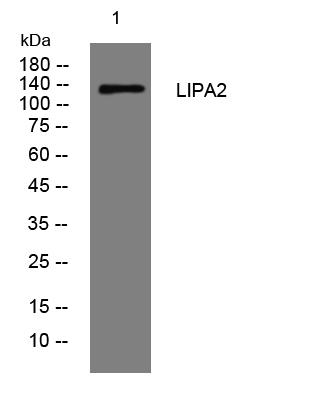LIPA2 rabbit pAb
- Catalog No.:YT6638
- Applications:WB;ELISA;IHC
- Reactivity:Human;Mouse
- Target:
- LIPA2
- Gene Name:
- PPFIA2
- Protein Name:
- LIPA2
- Human Gene Id:
- 8499
- Human Swiss Prot No:
- O75334
- Mouse Gene Id:
- 327814
- Mouse Swiss Prot No:
- Q8BSS9
- Immunogen:
- Synthesized peptide derived from human LIPA2 AA range: 49-99
- Specificity:
- This antibody detects endogenous levels of LIPA2 at Human/Mouse
- Formulation:
- Liquid in PBS containing 50% glycerol, 0.5% BSA and 0.02% sodium azide.
- Source:
- Polyclonal, Rabbit,IgG
- Dilution:
- WB 1:500-2000;IHC 1:50-300; ELISA 2000-20000
- Purification:
- The antibody was affinity-purified from rabbit antiserum by affinity-chromatography using epitope-specific immunogen.
- Concentration:
- 1 mg/ml
- Storage Stability:
- -15°C to -25°C/1 year(Do not lower than -25°C)
- Molecular Weight(Da):
- 138kD
- Background:
- The protein encoded by this gene is a member of the LAR protein-tyrosine phosphatase-interacting protein (liprin) family. Liprins interact with members of LAR family of transmembrane protein tyrosine phosphatases, which are known to be important for axon guidance and mammary gland development. It has been proposed that liprins are multivalent proteins that form complex structures and act as scaffolds for the recruitment and anchoring of LAR family of tyrosine phosphatases. This protein has been shown to bind the calcium/calmodulin-dependent serine protein kinase (MAGUK family) protein (also known as CASK) and proposed to regulate higher-order brain functions in mammals. Alternative splicing results in multiple transcript variants. [provided by RefSeq, Sep 2013],
- Function:
- domain:The N-terminal coiled coil regions mediate homodimerization preferentially and heterodimerization type alpha/alpha. The C-terminal, non-coiled coil regions mediate heterodimerization type alpha/beta and interaction with PTPRD, PTPRF and PTPRS.,function:Alters PTPRF cellular localization and induces PTPRF clustering. May regulate the disassembly of focal adhesions. May localize receptor-like tyrosine phosphatases type 2A at specific sites on the plasma membrane, possibly regulating their interaction with the extracellular environment and their association with substrates.,similarity:Belongs to the liprin family. Liprin-alpha subfamily.,similarity:Contains 3 SAM (sterile alpha motif) domains.,subcellular location:Colocalizes with PTPRF at the cell surface.,subunit:Forms homodimers and heterodimers with liprins-alpha and liprins-beta. Interacts with the second PTPase domain of PTPRD,
- Subcellular Location:
- Cytoplasm . Cell surface . Cell projection, dendritic spine . Colocalizes with PTPRF at the cell surface.
- Expression:
- Expressed only in brain.
- June 19-2018
- WESTERN IMMUNOBLOTTING PROTOCOL
- June 19-2018
- IMMUNOHISTOCHEMISTRY-PARAFFIN PROTOCOL
- June 19-2018
- IMMUNOFLUORESCENCE PROTOCOL
- September 08-2020
- FLOW-CYTOMEYRT-PROTOCOL
- May 20-2022
- Cell-Based ELISA│解您多样本WB检测之困扰
- July 13-2018
- CELL-BASED-ELISA-PROTOCOL-FOR-ACETYL-PROTEIN
- July 13-2018
- CELL-BASED-ELISA-PROTOCOL-FOR-PHOSPHO-PROTEIN
- July 13-2018
- Antibody-FAQs
- Products Images

- Western blot analysis of lysates from MDA-MB cells, primary antibody was diluted at 1:1000, 4°over night

- Immunohistochemical analysis of paraffin-embedded human liver cancer. 1, Antibody was diluted at 1:200(4° overnight). 2, Tris-EDTA,pH9.0 was used for antigen retrieval. 3,Secondary antibody was diluted at 1:200(room temperature, 45min).



